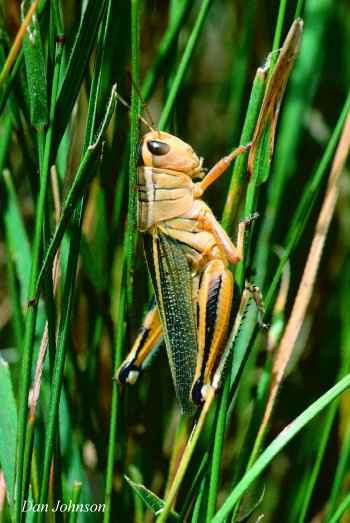Non-urgent government operations are closed December 24 to January 1, reopening January 2. View available services during this period.
Identification
The two-striped grasshopper (Melanoplus bivittatus) is widespread throughout Canada and common throughout Alberta.
The adult grasshoppers are brownish or greenish with black or brown markings. They are approximately 26 to 40 mm (1.0 to 1.6 inches) in length. They have 2 pale stripes extending back from the eyes to the tips of the forewings. A solid longitudinal black stripe is evident on the hind legs (Figure 1). Immature grasshoppers are green to yellowish brown.
The two-striped grasshopper has the heaviest body weight of the spur-throated grasshoppers discussed in this section: migratory, Packard’s and two-striped. It rarely flies far, but can walk well into a crop as it feeds.
For general grasshopper information, see Overview.

Figure 1. An adult two-striped grasshopper. Note the black stripe on the hind leg as well as the 2 distinct stripes on top of the body running the full length of the grasshopper.
Habitat
M. bivittatus is very common in the heavier-textured soil zones. It is found along roadsides, in dried-out marshes, and in fields with crops.
Food supply
The two-striped grasshopper prefers lush foliage such as many of the weed species found associated with marshes and roadside ditches. It has a wide range of host plants: grass, cereal crops and broad-leafed crops like canola and the pulses, even safflower. Young two-stripe grasshoppers will feed on lentil flower and buds and can also can slow or kill young plants. Later grasshopper stages will clip lentil pods. Occasionally, it may feed extensively on some of the trees commonly used as shelterbelts.
Host plants
Two-striped grasshoppers feed on grasses and broad-leaved plants. The broad-leaved plants are necessary for maximum growth. They prefer the lush growth around edges of streams, marshes and cultivated fields. Hosts include weeds and most crops, especially alfalfa and vegetables, and occasionally trees and shrubs. This species was first noted in large numbers in 1932 after broad-leaved weeds became common on the Prairies.
Life cycle
Overwintering
This species overwinters in the egg stage. Drift ridges of soil in abandoned fields that suffered severe wind erosion are favoured egg laying sites. Other areas include heavier textured soils along roadsides, closely cropped pastures, fence rows, ditch banks, prairie sod and field margins, but not cropped fields.
Air temperature must be above 20°C and soil moisture between 10 and 20% for egg deposition to occur. Forty to 100 eggs are laid per pod; only 2 or 3 pods are laid by each female during August and September.
Spring appearance
First instar nymphs appear in late May to early June.
Number of generations
As with all of Alberta's grasshopper pests, two-striped grasshoppers have one generation per year.
Damage assessment
Damage description
Damage to cereal crops is generally concentrated near field margins and is caused when hatchling grasshoppers move out of egg beds into field edges; damage to grasslands tends to be more evenly distributed.
Damage to cereals includes leaf notching and stripping but is most costly when stems are severed just below the heads of maturing or mature crops. When grasshopper numbers are extremely high and natural plant hosts in short supply, grasshoppers will consume or attempt to consume any plants or plant products that they come upon during their migrations in search of food.
Sampling and monitoring methods
Walk through the infested area and estimate the number of grasshoppers per square metre as they jump in front of you. A sampling 'T' will likely improve your estimate. The 'T' consists of a metre-long measuring stick, carried by a handle so that a square metre can be visualized at crop height. Walk and carry the 'T' just above the crop.
Late summer and fall surveys of grasshopper adults have been carried out by Agriculture Fieldmen in Alberta since 1932. Grasshopper population maps are produced yearly from data collected in about 1,700 townships.
Spring surveys of grasshoppers and grasshopper eggs are also conducted in years when high grasshopper numbers are expected. In this way, improved estimates are obtained for time of hatch, population density, and the effects of predators and parasites.
Natural enemies
The two-striped grasshopper has a greater number of natural enemies of the egg stage than have the clear-winged or migratory grasshoppers. The nymphs and adults are attacked by at least 12 species of insect parasites, 2 mermithid nematode species, 3 microbial pathogens and by various birds, small mammals, and parasitic mites. Insect parasites are most abundant 2 or 3 years after an outbreak.
There are various records of heavy mortality from fungus disease to which the two-striped grasshopper seems particularly susceptible. Red mites have infested up to 100% of a population; however, about 8% is a more normal figure. Their effect on these grasshoppers is unknown.
Find out about other grasshopper natural enemies.
Economic thresholds
The economic threshold or density of a pest at which control measures become economically viable has been established in most cereal crops. Find out about determining factors and types of crop loss: Grasshopper – Economic thresholds.